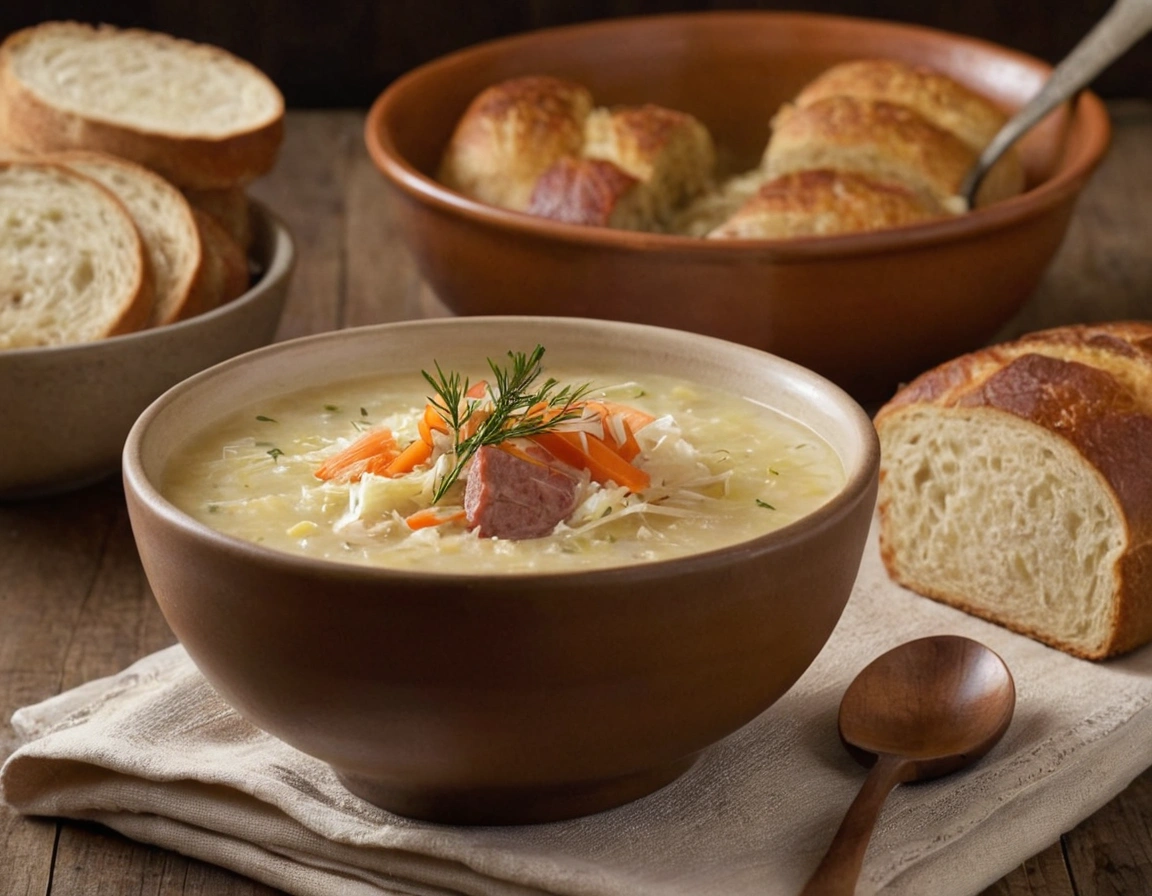The History of Sauerkraut Soup – A Tangy Tradition
Sauerkraut soup is more than just a humble bowl of warm, fermented cabbage stew—it’s a deeply rooted culinary tradition that spans across centuries and continents. From rural kitchens in Eastern Europe to modern wellness-focused homes around the world, sauerkraut soup has earned its place as a nourishing comfort food beloved for both its bold flavor and its cultural significance.
A Dish Steeped in History
The origins of sauerkraut soup can be traced back to Central and Eastern Europe, where harsh winters and limited fresh produce led to the widespread use of fermented vegetables. Sauerkraut, made by fermenting shredded cabbage with salt, was a staple in many households thanks to its long shelf life and nutritional value. Turning this fermented cabbage into a warm, hearty soup was a natural evolution—a way to stretch ingredients, feed families, and stay nourished during the colder months.
In Poland, the dish is known as Kapusniak and is traditionally made with pork or smoked sausage, potatoes, and root vegetables. In Germany, you’ll find a version called Sauerkrautsuppe, often flavored with caraway seeds and served with hearty rye bread. Ukraine, Slovakia, and Hungary all have their own regional twists, some with barley or beans, others with paprika or dill.
Ingredients That Bring Bold Flavor
What sets sauerkraut soup apart from other comfort food recipes is its complex flavor profile, achieved through a thoughtful combination of simple yet powerful ingredients. Each element of the dish plays a key role in building layers of flavor—tangy, smoky, earthy, and savory—resulting in a soup that’s deeply satisfying and unforgettable.
Sauerkraut: The Star of the Show
At the heart of the dish is sauerkraut, the fermented cabbage that gives the soup its signature tang. Sauerkraut not only delivers bold, acidic notes that brighten the entire dish, but it also brings a host of health benefits, including probiotics that support gut health. When simmered in broth, its sharpness mellows slightly, blending beautifully with the other ingredients while still keeping its distinctive edge.
For the best results, opt for raw, unpasteurized sauerkraut if possible—it has a fresher taste and contains active cultures. You can rinse it briefly to reduce its intensity, or use it straight from the jar for maximum punch.
Aromatic Vegetables: Building the Flavor Base
Like many great soups, onions, garlic, and carrots form the foundation of sauerkraut soup. These aromatics are usually sautéed first to develop a sweet and savory base that complements the sourness of the sauerkraut.
- Onions add depth and a subtle sweetness.
- Garlic infuses the broth with a warming, slightly pungent note.
- Carrots contribute a touch of natural sweetness and color balance.
Together, these ingredients round out the soup and prevent it from tasting too acidic or flat.
Potatoes: Earthy and Filling
Potatoes are a common addition to traditional sauerkraut soup recipes, offering a mild, starchy counterpoint to the sour kraut. They also make the soup more hearty and filling—perfect for cold-weather comfort food. Waxy potatoes like Yukon Gold hold their shape well during simmering, while russets break down slightly to thicken the broth.
Some modern versions swap out potatoes for cauliflower or white beans for a low-carb or higher-protein twist.
Smoked Meats: Depth and Heartiness
Adding smoked meats like kielbasa, bacon, or ham hock gives sauerkraut soup an extra layer of rich, umami flavor. The smokiness pairs exceptionally well with the tang of the sauerkraut, creating a robust, meaty base that lingers on the palate.
For vegetarians or vegans, smoked paprika or liquid smoke can be used to mimic this depth of flavor without any animal products.
Broth and Seasonings: Tying It All Together
The soup comes together with a good-quality broth, either vegetable, chicken, or beef depending on dietary preference. The broth should complement the other ingredients, not overpower them. Seasonings like bay leaves, black pepper, paprika, caraway seeds, and marjoram are commonly used to enhance the dish further.
Caraway seeds, in particular, are a traditional Eastern European seasoning that adds a slightly sweet, nutty flavor and aids digestion—perfect when paired with fermented cabbage.

In the end, it’s the balance of contrasting elements—sour and savory, fresh and smoky, light and hearty—that gives sauerkraut soup its bold and comforting flavor. These simple ingredients, when combined with care, deliver a deeply flavorful experience that feels both traditional and timeless.
Step-by-Step Guide to Making Sauerkraut Soup
Making sauerkraut soup at home is simple, rewarding, and surprisingly flexible. Whether you’re aiming for a traditional Eastern European version or a modern twist, the key is in the methodical layering of flavors. Below is a step-by-step guide to help you master the process and create a pot of this soulful, tangy soup in your own kitchen.
1. Prepare Your Ingredients
Before you start cooking, it’s best to have all your ingredients chopped, measured, and ready to go. This not only makes the process smoother but also ensures nothing is forgotten in the rush.
Essential Ingredients:
- 2 tablespoons oil or butter
- 1 large onion, finely chopped
- 2 cloves garlic, minced
- 2 carrots, diced
- 2 medium potatoes, peeled and cubed
- 3 cups sauerkraut, drained (rinsed if desired for less tang)
- 6 cups vegetable or chicken broth
- 1 bay leaf
- 1 teaspoon smoked paprika
- 1/2 teaspoon caraway seeds (optional but traditional)
- Salt and pepper to taste
- Optional: kielbasa or smoked sausage, sliced
Chop all vegetables uniformly for even cooking. If using sausage or bacon, slice or dice it ahead of time.
2. Sauté the Aromatics
Begin by heating oil or butter in a large soup pot over medium heat.
Add chopped onions and carrots, sautéing for about 5 minutes until softened. Then stir in the garlic and cook for another 30 seconds, just until fragrant.
If you’re including smoked meats, now’s the time to add them. Let them brown slightly to release their flavorful oils—this step adds an extra layer of richness to the soup base.
3. Add the Sauerkraut and Seasonings
Next, stir in the sauerkraut, combining it thoroughly with the sautéed vegetables and meat. Let it cook for 2–3 minutes so it can absorb some of the base flavors. This is a good moment to sprinkle in your paprika, caraway seeds, and bay leaf, which will infuse the soup as it simmers.
You can taste the sauerkraut here—if it’s too tangy for your liking, a quick rinse before adding will tone it down.
4. Pour in the Broth and Simmer
Pour in the broth and stir to combine. Bring the mixture to a gentle boil, then reduce the heat and let it simmer uncovered for 25–30 minutes. This gives the potatoes time to soften and the flavors to meld beautifully.
If you prefer a thicker soup, mash a few potato chunks in the pot with the back of a spoon during the last few minutes of cooking.
Taste and adjust salt and pepper as needed—keep in mind that sauerkraut is naturally salty, so always season at the end to avoid overdoing it.
5. Finish and Serve
Once everything is cooked and tender, remove the bay leaf. You can serve the soup as is, or for extra comfort, top each bowl with a dollop of sour cream, a sprinkle of fresh parsley, or a side of crusty rye bread.
If you’ve made a large batch, sauerkraut soup stores well in the fridge for up to 4–5 days, and the flavor improves over time.
Sauerkraut Soup Variations to Try
One of the reasons sauerkraut soup has remained a cherished dish across cultures and generations is its versatility. While the classic recipe calls for sauerkraut, potatoes, broth, and sometimes smoked meat, there are countless delicious variations that reflect different regional styles, dietary preferences, and creative spins.
Here are some tasty and inspiring versions of sauerkraut soup that you can try at home:
1. Classic Eastern European Style (Kapusniak)
This traditional version hails from countries like Poland, Ukraine, and Slovakia. It’s hearty, rustic, and rich with flavor.
Typical additions include:
- Smoked pork ribs, bacon, or sausage
- Root vegetables like celery root or parsnip
- Caraway seeds and bay leaves for seasoning
- A dollop of sour cream for serving
This version is especially warming in winter, often served with dark rye bread or crusty rolls. It’s slow-cooked for maximum depth and is the most historically authentic rendition.
2. Vegetarian or Vegan Sauerkraut Soup
Perfect for plant-based eaters, this version is full of flavor even without meat.
Key ingredients might include:
- Vegetable broth
- White beans or lentils for protein and texture
- Smoked paprika or liquid smoke to replicate the umami depth of bacon
- Potatoes, carrots, and leeks for a nourishing base
The natural tang of sauerkraut still shines, but it’s balanced by the earthiness of legumes and the subtle spice of herbs like thyme or parsley.
3. German-Inspired Sauerkraut Soup
Germany has its own spin on this comfort classic, usually a bit lighter and often incorporating beer or wine.
German twists might include:
- A splash of dry white wine or lager in the broth
- Bratwurst or frankfurters sliced into rounds
- Marjoram, nutmeg, or mustard seeds for seasoning
- Topped with chives or parsley for freshness
This version often skips potatoes and instead focuses on a smooth, tangy broth rich in sausage flavor—excellent with a warm pretzel or bread on the side.
4. Spicy Sauerkraut Soup
Looking to kick up the heat? A spicy version brings a bold, fiery edge that plays well with the sourness of the kraut.
Additions might include:
- Hot paprika or chili flakes
- Chorizo or spicy Italian sausage
- A touch of cayenne pepper or hot sauce
- Serve with a dollop of Greek yogurt or crema to tame the spice
This twist is perfect for spice lovers and adds a modern flair to a traditional base.
5. Creamy Sauerkraut Soup
For a more indulgent, mellowed version, a creamy sauerkraut soup offers richness without losing the signature tang.
Common ingredients include:
- Heavy cream, sour cream, or coconut cream
- Butter and flour roux to thicken the base
- Optional addition of mushrooms for earthiness
- Garnished with fresh herbs like dill or parsley
This variation is smooth, velvety, and comforting—great for a cold, cozy evening.
With just a few ingredient swaps or creative additions, you can make sauerkraut soup your own. Whether you’re craving something spicy, smoky, light, or rich, there’s a variation to suit your taste—and each one still captures the bold essence of this tangy tradition.

Sauerkraut Soup
Ingredients
- 2 tablespoons olive oil or butter
- 1 large onion finely chopped
- 2 cloves garlic minced
- 2 medium carrots diced
- 2 medium potatoes peeled and cubed
- 3 cups sauerkraut rinsed and drained, or use as-is for more tang
- 6 cups vegetable or chicken broth
- 1 bay leaf
- 1 teaspoon smoked paprika
- 1/2 teaspoon caraway seeds optional
- Salt and black pepper to taste
- 200 g kielbasa or smoked sausage sliced (optional for a meaty version)
- Optional toppings: sour cream fresh parsley, rye bread
Instructions
- Sauté the base: In a large soup pot, heat olive oil or butter over medium heat. Add chopped onion and diced carrots. Cook for about 5–6 minutes until softened. Stir in garlic and cook for another 30 seconds.
- Add meat (if using): Add the sliced sausage or kielbasa. Sauté for a few minutes until lightly browned to release flavor.
- Combine sauerkraut and spices: Stir in the sauerkraut, smoked paprika, caraway seeds (if using), and bay leaf. Cook for 2–3 minutes to combine flavors.
- Simmer the soup: Pour in the broth and add the cubed potatoes. Bring to a gentle boil, then reduce heat and simmer uncovered for 25–30 minutes, or until potatoes are tender.
- Season and finish : Taste and adjust seasoning with salt and pepper. Remove bay leaf before serving.
- Serve and enjoy: Ladle hot into bowls. Garnish with a dollop of sour cream, a sprinkle of fresh parsley, or serve with hearty bread.
If you like more soup recipes, visit the tacos soup




